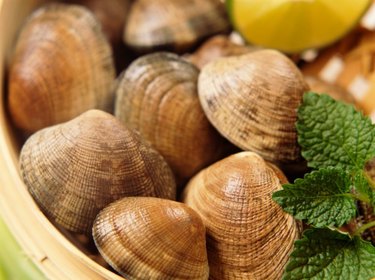Things You'll Need
Fishing gig
Mesh collection bag

In Topsail Island, North Carolina, there are several species of edible clam available for recreational clamming. Shallow tidal flats provide access to areas where clams live. While there are many techniques for catching clams, a method called "keyholing" is one of the simplest. Clams have two syphons that they use to filter water and food through. These syphons leave a characteristic hole in the surface of the sandy mud they are buried in that looks like an old-fashioned keyhole. Once spotted, you can dig under the hole using a three-pronged fishing spear, called a "gig," to find the clam.
Step 1
Locate an area on a tidal flat or sand bar that is a mixture of mud and sand and on which it is easy to walk. For the best locations, ask at local bait or fishing shops for advice.
Video of the Day
Step 2
Walk along and examine the ground in shallow water or dry areas near water at low tide. Look for the distinctive keyhole-shaped hole in the sandy mud that indicates a clam is just below the surface. The larger the hole, more often, the larger the clam.
Step 3
Insert the prongs of the gig into the keyhole about 3 to 5 inches to feel for the clam in the soil. If a clam is there, the prongs stop as if they have hit a rock.
Step 4
Insert the prongs of the gig into the soil next to the holes, if you find a clam, and dig under the hole. Lever the soil up and turn it over next to the hole. Sift through the soil to find the clam.
Step 5
Measure each clam and keep only those that are at or over the legal limit of 1 inch across the thickness of the shell. Keep up to 100 clams per day, with a limit of 200 clams if you are clamming with a boat.
Step 6
Place any keeper clams in a collection bag. To clean the clams of any sand or other debris, hang the bag from your boat or a dock or other structure in the sea water for several hours.
Tip
According to the North Carolina Sea Grant Extension Program, there is no season for clamming in North Carolina and you can harvest them at any time of the year. No license is required for recreational clamming.
Warning
Several regions in the Topsail Island area are restricted to clamming by law. The status of these regions may change from year to year. Check with the local extension office or the North Carolina Division of Marine Fisheries to determine where clamming is allowed in the area.
When cooking your clams, dispose of any that do not quickly snap shut when you tap their shell. These clams have died and are unsafe to eat.
Video of the Day